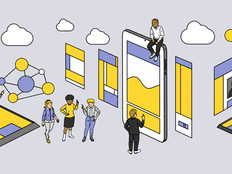The ‘Historical Hype Cycle’ of AI
Before talking about the current and projected impact of AI in education and other industries, Ramsey explained the concept of the “AI winter.”
He showed a graph on the “historical hype cycle” of AI that featured peaks and drops over a 70-year period.
There was a big peak in the mid-1960s, when there was an emergence of symbolic AI research and new insights into the possibility of training two-layer neural networks. A resurgence came in the 1980s with the invention of certain algorithms for training three-plus layer neural networks.
The graph showed a drop in the mid-1990s, as the computational horsepower and data did not exist to develop real-world applications for AI — a situation he calls an “AI winter.” We are in the middle of another resurgence today, he said.
There has been a huge increase in the amount of data and computer power that we have available, sparking research, Ramsey said. People have been able to start inventing algorithms and training not just three-layer neural networks but a 100-layer one.
“The question now is where we will go next,” he said. His answer? We will sustain progress, leading to “true” or “strong” AI — the point at which a machine’s intellectual capability is functionally equal to a human’s.
“The number of researchers working on this, the amount of money that’s being spent on this and the amount of research publications — it’s all growing,” he said. “And where Google is right now is on a plateau of productivity because we’re using AI in everything that we do, at scale.”
How AI Can Transform Higher Education in the Next Five Years
During his presentation, Ramsey showed an infographic that featured what machine learning could look like across a student’s journey through higher education, starting from their college search and ending with employment.
For example, he said, colleges and universities can apply machine learning when targeting quality prospective students to attend their schools. They can even automate call center operations to make contacting prospective students more efficient and deploy AI-driven assistants to engage with applicants in a personalized way, he said.
Once students are enrolled, they can also use AI chatbots to improve student support services, assisting new students in their adjustment to college. They can leverage adaptive learning technology to predict performance as they choose a path through school, and they can tailor material to their knowledge levels and learning styles.
For example, a machine learning algorithm helped educators at Ivy Tech Community College in Indianapolis identify at-risk students and provide early intervention, Ramsey said.
Ivy Tech shifted to Google Cloud Platform, which allowed the school to manage 12 million data points from student interactions and develop a flexible AI engine to analyze student engagement and success. For instance, a student who stops logging in to their learning management system or showing up to class would be flagged as needing assistance.
The predictions were 83 percent accurate, Ramsey said. “It worked quite well, and they were actually able to save students from dropping out, which makes a big difference because their funding is based on how many students they have,” he said.
As students near graduation and start their job searches, schools can also use AI to understand career trends and match them to a student’s competencies and skills. Machine learning can be used to better understand job listings and a jobseeker’s intent, matching candidates to their ideal jobs more quickly.
“At the end of the day, what we’re doing with these technologies is trying to understand who we are and how our minds work,” Ramsey said. “Once we fully understand that, we can build machines that function in the same way, and the possibilities are endless.”










